 |
| Double click to enlarge for reading what Viking has planned for the day. |
 |
| The port is at La Goulette. They run everyone through a shopping boulevard on the way to and from the port. |
 |
| Fake boat art on the way out of the port. Talking about leaving the port, the bus had to pass through three security checks after it started moving. |
 |
| Still raining as we approach a parking lot where the buses have to go through this narrow arch. |
 |
| The Medina contains many souks (market streets) full of a wide variety of merchandise. The octagonal minaret is on the Hammouda Bay Mosque built in 1655. |
 |
| Since it was a Sunday, many of the stores were closed. |
 |
| Mostly just my bus load of people here. |
 |
| Our guide had us stop at a shop that sold handmade wool hats called chichia (Tunisian headgear which is now only worn by the elderly). They sold for $20. |
 |
| The shopkeeper explained the manufacturing process. |
 |
| They also made some ladies hats, and I saw a couple on heads later. |
 |
| Another style resembled ball caps. |
 |
| There were tables and chairs for the people getting food from the various vendors. |
 |
| Ahead is the 141' minaret on the Ez-Zitouna Mosque. This mosque, with an Islamic university, is the oldest in Tunisia. |
 |
| Once on the roof, we had a better view of the minaret of the Hammouda Bay Mosque |
 |
| And the minaret of the Ez-Zitouna Mosque. There are an estimated 5400 mosques in Tunisia, 20 are underground and over 100 are in Tunis. |
 |
| Looking down on one of the souk hallways. |
 |
| After looking at the view, we were escorted halfway back down the stairs and into a large room surrounded by benches with rugs hanging on the walls. |
 |
| Once everyone was seated and offered mint tea, they started laying out rugs and telling us what they were made of. |
 |
| Most were gorgeous. |
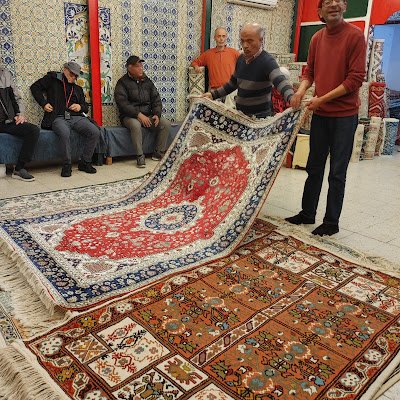 |
| The silk one changed color at different angles. Quoted cost was $2,500. I think he said there were around 1,000 knots per square inch on silk rugs. |
 |
| We were shown both sides of this rug. |
 |
| Because it is a larger thread, camel hair rugs have less knots per square inch. |
 |
| The colors make this look like a SW US rug. |
 |
| Once out of the souks, we headed back to our buses. Of course there are cats everywhere. |
 |
| The National Monument of the Kasbah is a memorial monument and a prominent symbol of several events in Tunisia. It is located in the center of the Kasbah Square in Tunis, facing the Town Hall |
 |
| The Town Hall |
 |
| Buses waiting in the parking lot behind the Town Hall. |
 |
| Arabic, French and English are taught in the schools. |
 |
| I think they were serious about stopping as there is both a stop light and a stop sign. |
 |
| Looks like this man was selling things in the median. |
 |
| Street signs. |
 |
| Our next stop was the Bardo Museum where we had to check in with the police before parking. |
 |
| Close up of some of it. |
 |
| The entrance hall is large. |
 |
| As the museum tells of the history of civilization in the area, it starts with the oldest know, the Punic. |
 |
| You might have to click on this to enlarge it for reading. |
 |
| 220 BC |
 |
| Trade |
 |
| We didn't get information on most of the mosaics we passed. |
 |
| Many were quite large. |
 |
| Where they didn't have all the mosaic, they showed us a dull image of what it probably looked like. |
 |
| The area we were entering was one that had been reserved for women when the building was a palace. |
 |
| Beautiful walls made of stucco |
 |
| Zodiac mosaic |
 |
| Dating to the third century, the mosaic was discovered in a villa at Sousse and depicts the poet writing his famous epic, The Aeneid, flanked by the muses of tragedy and history. |
 |
| Walking on more mosaics |
 |
| Hare and boar hunting |
 |
| Ceiling |
 |
| 5th century baptistry |
 |
| Our guide told us that the country overthrew the Islamic government in 2015. Now they are a democratic country having elected a new president four years ago. |
 |
| From the Bardo, we headed back to La Goulette area for a meal. Here we are passing the airport. |
 |
| We didn't get any choice on the meal but were just handed plates of chicken, vegetable and couscous. |
 |
| This restroom had toilet paper, but it also had this sprayer hose you could use. Some places didn't have toilet paper. |
 |
| Glad the bus driver knew where to go. The guide told us that there are 100 million olive trees in the country and produce a lot of olive oil. |
 |
| The average winter temperature is 13°C (55°F) and the average summer temperature is 27°C (80°F). |
 |
| He also told us that the United Arab Emirates are building a city by Tunis. |
 |
| The Carthage amphitheater is the 3rd largest in the world. |
 |
| It is from the 4th century and could hold 300,000 spectators. |
 |
| Carthage was founded in 814 BC. |
 |
| Since the monument has been raided by looters, the stone and metal have been levelled to the ground. Thus, only the arena remains open in the middle of a grove of pine trees |
 |
| Yea it's pouring again just as we get to the next Carthage stop. Most of the people stayed on the bus. |
 |
| Information panels are housed under some shelters, so we check those out while the guide talks. It's hard to get any photos of the panels as people are huddled next to them out of the pouring rain. |
 |
| We vacate the shelters and head up the walkway to check out the Punic era necropolis. |
 |
| At least we had a hard surface to walk on. |
 |
| The walkway led us to an overlook of the Baths of Antoninus or Baths of Carthage, the largest set of Roman thermae built on the African continent and one of three largest built in the Roman Empire. |
 |
| The baths were destroyed by the Vandals in 439 AD, and the stone was reused by the Arabs during the construction of Tunis. |
 |
| To the southwest a huge semi-circular construction was discovered with around 80 seats, which archaeologists first thought to be a theatre, before realizing that it was, in fact, a communal latrine! |
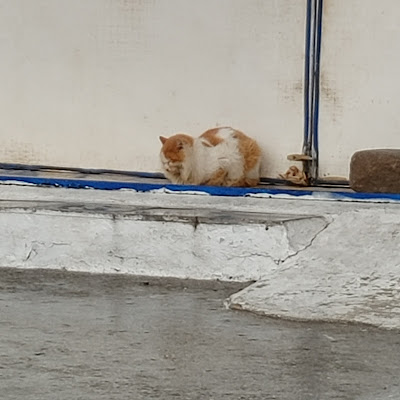 |
| The cats didn't like the rain either. |
 |
| Next stop, the town of Sid Bou Said - after we got by all the vendors. |
 |
| Brilliant blue-painted doors and trellises reminded me of the blue and white buildings on the island of Santorini, Greece. |
 |
| Slice of the Mediterranean Sea |
 |
| Vendors were quite insistent here. We were told to offer half the price of whatever the vendor told us. I did purchase some jewelry for $30 after the vendor initially told me a price of $250. |
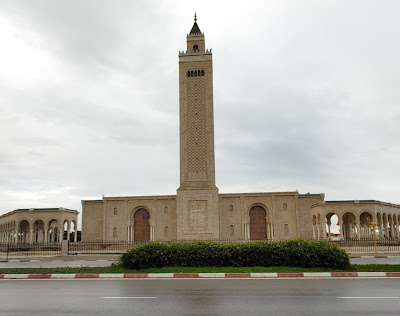 |
| We stopped for a view of this mosque while we were heading back to the ship. |
 |
| Police vehicle as we approached the port. Of course it was raining, and the wind was blowing the rain horizontal as we walked back through the security checkpoint. |

















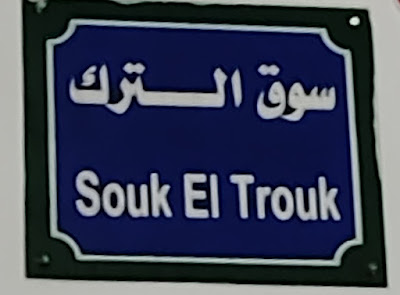







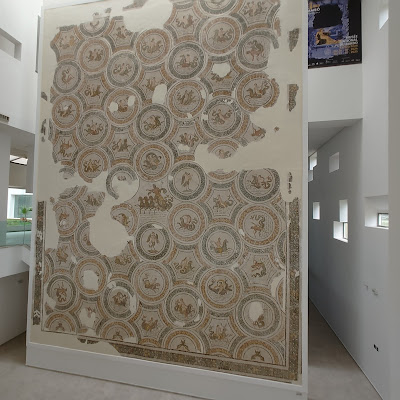




































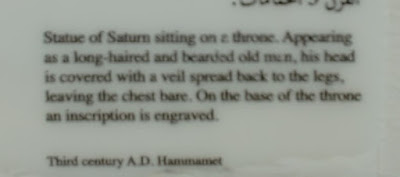


























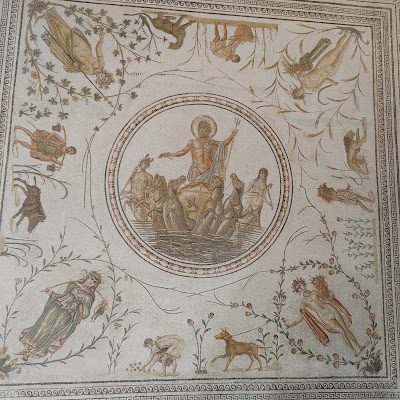

















































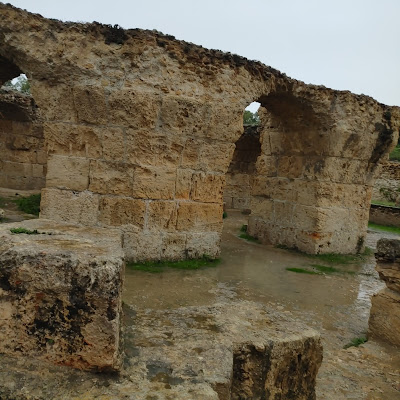










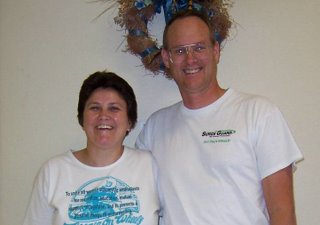
No comments:
Post a Comment